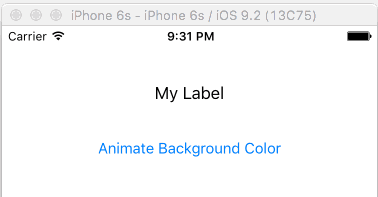How to animate the background color of a UILabel?
This looks like it should work, but doesn't. The color turns green at once.
self.labelCorrection.backgroundColor = [UIColor whiteColor];
[UIView animateWithDuration:2.0 animations:^{
self.labelCorrection.backgroundColor = [UIColor greenColor];
}];
Solution 1:
I can't find it documented anywhere, but it appears the backgroundColor property of UILabel is not animatable, as your code works fine with a vanilla UIView. This hack appears to work, however, as long as you don't set the background color of the label view itself:
#import <QuartzCore/QuartzCore.h>
...
theLabel.layer.backgroundColor = [UIColor whiteColor].CGColor;
[UIView animateWithDuration:2.0 animations:^{
theLabel.layer.backgroundColor = [UIColor greenColor].CGColor;
} completion:NULL];
Solution 2:
Swift
-
(important) Set the UILabel's background color to clear (either in IB or in code). For example:
override func viewDidLoad() { super.viewDidLoad() myLabel.backgroundColor = UIColor.clear } -
Animate the layer background color.
@IBAction func animateButtonTapped(sender: UIButton) { UIView.animate(withDuration: 1.0, animations: { self.myLabel.layer.backgroundColor = UIColor.red.cgColor }) }
Note that CGColor is added after the UIColor.
Result

Solution 3:
Swift 3
To animate your label background color from white to green, set up your label like this:
self.labelCorrection.backgroundColor = UIColor.clear
self.labelCorrection.layer.backgroundColor = UIColor.white.cgColor
Animate like this:
UIView.animate(withDuration: 2.0) {
self.labelCorrection.layer.backgroundColor = UIColor.green.cgColor
}
To go back to the original state, so you can animate again, make sure you remove animations:
self.labelCorrection.layer.backgroundColor = UIColor.white.cgColor
self.labelCorrection.layer.removeAllAnimations()
Solution 4:
You CAN animate it, but I had to first set it (programmatically) to clearColor for some reason. Without that, the animation either didn't work or wasn't visible.
I am animating the background color of a UILabel in a custom table cell. Here is the code in the willDisplayCell method. I wouldn't try to set the animation in cellForRow, since a lot of the layout gets tinkered with by the table.
- (void)tableView:(UITableView *)tableView willDisplayCell:(UITableViewCell *)cell forRowAtIndexPath:(NSIndexPath *)indexPath
{
((RouteListCell *)cell).name.backgroundColor = [UIColor clearColor];
[((RouteListCell *)cell).name backgroundGlowAnimationFromColor:[UIColor whiteColor] toColor:[UIColor redColor] clearAnimationsFirst:YES];
}
Here's my animation routine:
-(void) backgroundGlowAnimationFromColor:(UIColor *)startColor toColor:(UIColor *)destColor clearAnimationsFirst:(BOOL)reset;
{
if (reset)
{
[self.layer removeAllAnimations];
}
CABasicAnimation *anAnimation = [CABasicAnimation animationWithKeyPath:@"backgroundColor"];
anAnimation.duration = 1.00;
anAnimation.repeatCount = HUGE_VAL;
anAnimation.autoreverses = YES;
anAnimation.fromValue = (id) startColor.CGColor; // [NSNumber numberWithFloat:1.0];
anAnimation.toValue = (id) destColor.CGColor; //[NSNumber numberWithFloat:0.10];
[self.layer addAnimation:anAnimation forKey:@"backgroundColor"];
}